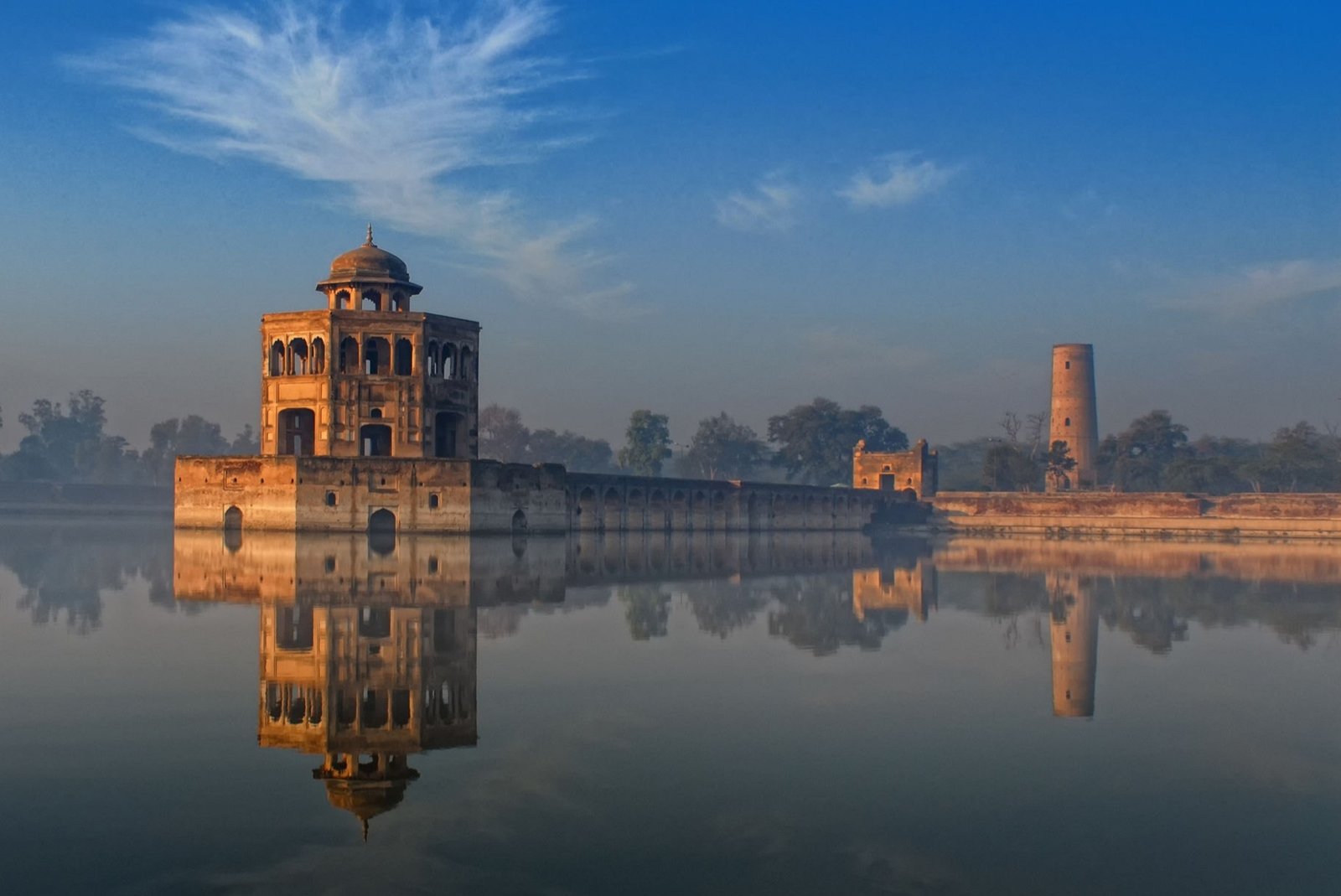

The History of Hiran Minar:

A Testament to Mughal Grandeur
The Mughal Empire is known for its magnificent architecture, from the Taj Mahal to the Red Fort, but nestled in the city of Sheikhupura, Pakistan, stands a lesser-known gem — the Hiran Minar. This towering structure is not just a demonstration of Mughal architectural prowess, but it also tells a unique tale of love, loyalty, and reverence. The Hiran Minar, often overlooked in the annals of history, offers a glimpse into the personal life of Emperor Jahangir, who built this monument in memory of his beloved pet antelope. This article explores the history, cultural significance, and architectural grandeur of the Hiran Minar, a site that remains a fascinating example of Mughal ingenuity.
Origins of the Hiran Minar: A Tribute to Loyalty
Hiran Minar, which translates to “Deer Tower,” was built by Emperor Jahangir in 1606 as a tribute to his favorite pet antelope, Mansraj. This structure is emblematic of the Mughal tradition of honoring animals, which were often considered symbols of loyalty and companionship. While the empire was known for grandiose buildings like forts and palaces, Hiran Minar stands apart as a monument with a deeply personal backstory. It is believed that Jahangir was an avid animal lover, with a particular fondness for Mansraj, who was his hunting companion for many years. The death of the antelope left the emperor devastated, leading him to commission the construction of this memorial in its honor.
The tradition of building monuments for animals may seem unusual today, but it was not uncommon in the Mughal period. Jahangir’s court was filled with exotic animals, many of which were honored in some way. The construction of Hiran Minar was a reflection of the emperor’s deep emotional bond with his pet, demonstrating that Mughal rulers were not just warriors and conquerors but also individuals with personal sentiments and attachments.
Architectural Features of Hiran Minar
Standing at 30 meters, the Hiran Minar is a towering, circular structure made of red sandstone and brick, showcasing the typical architectural elements of the Mughal era. The tower itself is adorned with decorative panels, and at its summit, one can find a platform that offers panoramic views of the surrounding landscape. The most striking feature of the tower is the presence of 210 holes, which are believed to have been used for mounting decorative trophies, particularly animal heads from Jahangir’s hunting expeditions. This gives the tower a unique appearance, one that is not replicated in other Mughal structures.
Surrounding the Hiran Minar is a large square water tank that measures 229 by 273 meters. At each corner of the tank is a small pavilion, known as a “baradari,” which was used for leisure and entertainment by the Mughal royalty. The tank itself was likely used for water sports and other recreational activities, making Hiran Minar not just a monument but also a site of royal relaxation. In the center of the water tank is a small pavilion accessible by a causeway, where it is said that the emperor would sit and observe the wildlife and natural beauty around him.
The overall design of the Hiran Minar complex reflects the Mughal fascination with geometry and symmetry, key principles in their architectural philosophy. The water tank, the baradaris, and the minar itself are all laid out in perfect alignment, showcasing the precision and skill of Mughal architects and engineers.
The Cultural Significance of Hiran Minar
The construction of Hiran Minar is not only significant for its architectural beauty but also for its cultural and symbolic meaning. In many ways, the tower represents the Mughal rulers’ close relationship with nature and wildlife. Jahangir, in particular, was known for his love of nature. His memoirs, the Tuzk-e-Jahangiri, are filled with observations about plants, animals, and natural phenomena. Hiran Minar serves as a reflection of this personal interest in the natural world, as well as the Mughal dynasty’s broader appreciation for art, beauty, and nature.
Moreover, the minar stands as an early example of animal conservation, albeit in a very different context than modern ideas of conservation. While hunting was a popular pastime among Mughal royals, their relationship with animals was complex. Jahangir’s decision to memorialize Mansraj demonstrates a deep respect and emotional connection to animals that was not merely utilitarian. This blend of personal sentiment, artistry, and respect for nature is what makes Hiran Minar stand out in the vast portfolio of Mughal monuments.
The Historical Context: Mughal Architecture During Jahangir’s Reign
To understand the significance of Hiran Minar, it is essential to place it within the broader context of Mughal architecture during Jahangir’s reign. While his father, Akbar, is credited with establishing the Mughal architectural style by blending Persian, Indian, and Central Asian influences, Jahangir continued this tradition and added his own touches. Jahangir’s period was one of artistic refinement, where architecture took on more aesthetic and ornamental qualities rather than merely serving functional or defensive purposes.
Jahangir was less interested in military conquests than in art and nature, and this is evident in the architecture from his reign. His buildings were characterized by delicate ornamentation, use of natural motifs, and an emphasis on creating beautiful, tranquil spaces. Hiran Minar, with its water tank, baradaris, and nature-inspired elements, fits perfectly into this aesthetic. It is a peaceful retreat rather than a grandiose palace or fort, reflecting Jahangir’s personal tastes and priorities.
The Role of Hiran Minar in the Mughal Landscape
While the Hiran Minar may not have the fame of other Mughal monuments, it played an important role in the royal landscape of the time. Located in what was then a hunting reserve, the structure served as a focal point for royal hunting expeditions. The surrounding area, filled with forests and wildlife, was a favorite retreat for the Mughal emperors, who would escape the heat and noise of the imperial capitals for the tranquility of nature. The hunting reserve was also used to breed and train animals for royal hunts, making it an integral part of Mughal courtly life.
Hiran Minar thus represents a convergence of two aspects of Mughal life: the pursuit of leisure and the appreciation of nature. Hunting, while a royal sport, was also an opportunity for the emperor and his court to immerse themselves in the natural world, and the Hiran Minar served as both a monument and a functional part of these activities. The structure, along with its surrounding pavilions and water tank, was designed to facilitate relaxation and reflection, offering a serene environment for the emperor to engage with the natural beauty around him.
Hiran Minar in Modern Times
Today, Hiran Minar is a popular tourist destination, drawing visitors from around the world who are eager to explore its history and architectural beauty. The site has been well-preserved, though it has undergone several restoration efforts over the years to maintain its structural integrity. Its location, just 40 kilometers from Lahore, makes it easily accessible to those looking to explore the lesser-known treasures of Mughal architecture.
In recent years, there has been a growing recognition of the importance of preserving such sites, not only for their historical and architectural value but also for their cultural and emotional significance. Hiran Minar, as a monument to a beloved pet, offers a unique insight into the personal life of Emperor Jahangir, making it a compelling site for both history enthusiasts and casual visitors.
Conclusion: A Monument of Personal and Historical Value
The Hiran Minar may not be as grand or as well-known as other Mughal monuments, but it is a structure that tells a deeply personal story. Built in memory of Jahangir’s pet antelope, it stands as a testament to the emperor’s love for nature, his emotional attachments, and his appreciation for art and beauty. The architectural features of the tower and its surrounding complex highlight the Mughal skill in blending functionality with aesthetic appeal, while the historical context of its construction offers insight into the cultural values of the time.
As more people visit the Hiran Minar and learn about its history, it is becoming increasingly recognized as a significant part of the Mughal architectural legacy. It serves as a reminder that even the most powerful rulers had personal moments of love and loss, and that these moments could inspire the creation of lasting monuments. Hiran Minar is not just a tower — it is a symbol of loyalty, affection, and the timeless bond between humans and animals.















